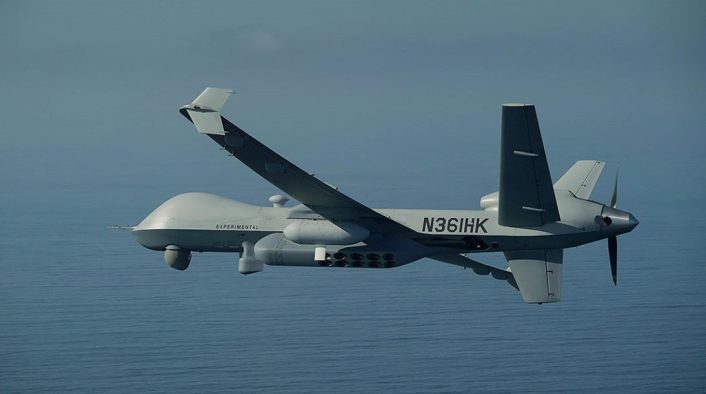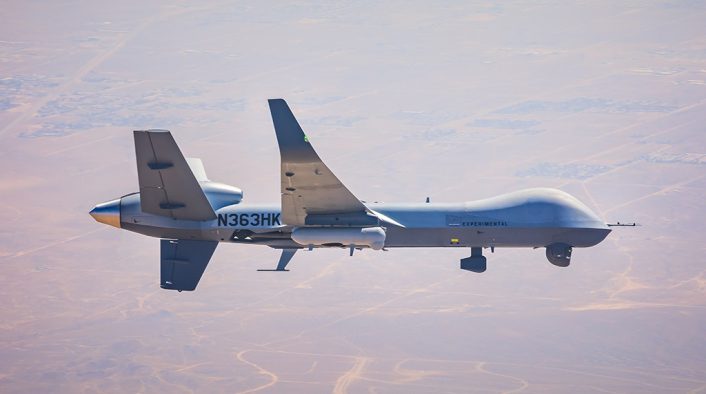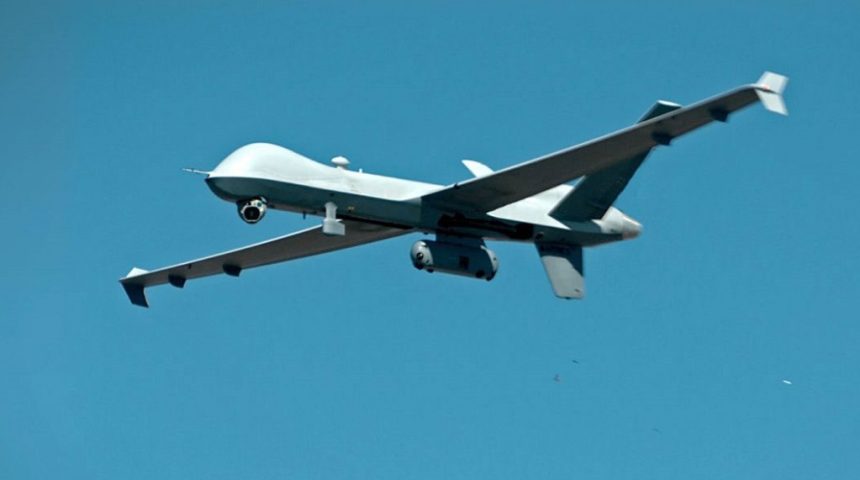The self-protection pod was successfully tested in October 2020 and is one of many new capabilities for the MQ-9 Reaper Remotely Piloted Aircraft tested last year.
General Atomics Aeronautical Systems recently announced some of the new capabilities that have been tested for the MQ-9 Reaper (in particular, the MQ-9A Block 5) Remotely Piloted Aircraft (RPA) in the last months of 2020. Among all the tests, one of the most interesting is undoubtedly the newly developed Self-Protection Pod (SPP) that could be a first for an unmanned aircraft.
According to GA’s press release, the successful demonstration was held on Oct. 28, 2020, at the Yuma Proving Grounds (YPG), as part of a Cooperative Research and Development Agreement (CRADA) with the U.S. Special Operations Command (USSOCOM) and with the support of the Air National Guard (ANG), the U.S. Navy (USN), Raytheon Intelligence & Space, BAE Systems, Leonardo, Leonardo DRS, and Terma North America.
During the test, the MQ-9 was able to successfully employ the Electronic Warfare (EW) pod to track Radio Frequency (RF) and Infrared (IR) missile threats, deploy countermeasures, and provide real-time threat awareness and protection in a simulated contested environment. In 2017, GA tested a similarly shaped pod, but that time it was equipped only with a Raytheon AN/ALR-69A(V) Radar Warning Receiver (RWR) to demonstrate the radar threat detection capability for future development and its utility to enhance aircrew situational awareness.
“Threat awareness and survivability are critical capabilities needed to enable the MQ-9 to operate in a contested environment,” said GA-ASI President, David R. Alexander. “GA-ASI is committed to expanding the mission envelope of the MQ-9 to enable not only the warfighters’ needs of today, but also to ensure the platform remains a survivable, capable, and highly adaptable platform for the future fight.”
The Self-Protection Pod provides, according to the press release, full-spectrum awareness and countermeasures. In addition to the aforementioned AN/ALR-69A(V) RWR, the pod has been integrated with the Leonardo DRS AN/AAQ-45 Distributed Aperture Infrared Countermeasure (DAIRCM) System, for IR missile detection, and the BAE Systems ALE-47 Countermeasures Dispenser System, the standard chaff and flares dispenser used on US-built aircraft.
An interesting note added by GA is that the ALE-47 was used to demonstrate the employment also of Radio Frequency (RF) countermeasures, specifically the Leonardo BriteCloud Expendable Active Decoy (EAD), a self-contained Digital Radio Frequency Memory (DRFM)-based expendable decoy that has been designed to be employed like standard chaff and flares, without the need of additional equipment or modifications to the aircraft.
The RWR, DAIRCM and ALE-47 are managed by the Terma AN/ALQ-213 Electronic Warfare Management System (the same system also used on the F-16 and other US-made aircraft), which provides the interface, health, status, and command and control for the various systems installed in the pod. The AN/ALQ-213 can operate both in manual and automatic mode, however GA explicitly mentioned that it was set to automatically dispense the appropriate sequencing pattern and expendables to protect the MQ-9, reducing the crew’s workload.

Another interesting test saw the Reaper performing an unusual mission, testing the world’s first self-contained Anti-Submarine Warfare (ASW) capability for an Unmanned Aircraft System (UAS). According to GA, the test happened on November 24 on an unspecified U.S. Navy Pacific test range, where the MQ-9A Block 5 demonstrated an ‘A’ size sonobuoy carriage, release, process and control. This capability is being developed in partnership with the U.S. Navy, under a CRADA with Naval Air Systems Command, for the new MQ-9B SeaGuardian.
“This demonstration is a first for airborne ASW. The successful completion of this testing paves the way for future development of more Anti-Submarine Warfare capabilities from our MQ-9s,” said General Atomics’ President. “We look forward to continuing collaboration with the U.S. Navy as they explore innovative options for distributed maritime operations in the undersea domain.”
The company specified in the press release that the aircraft employed seven Directional Frequency Analysis and Recording (DIFAR-AN/SSQ-53G), two Directional Command Activated Sonobuoy System (DICASS-AN/SSQ-62F) and one Bathythermograph (BT-AN/SSQ-36B) sonobuoys to initiate prosecution and continuously track a MK-39 EMATT (Expendable Mobile ASW Training Target) over a three-hour period. The buoys relayed bathythermal and acoustic data via the Reaper’s Satellite Communications (SATCOM) link to the Laguna Flight Operations Facility at Yuma Proving Grounds in order to remotely generate a target track in real time.
To perform the mission, the MQ-9 was equipped with a specifically developed pneumatic sonobuoy dispenser system (SDS), capable of safely carrying and deploying 10 U.S. Navy compliant ‘A’ size or 20 ‘G’ size sonobuoys per pod. The MQ-9B SeaGuardian will be equipped with up to four SDS pods, carrying up to 40 ‘A’ size or 80 ‘G’ size sonobuoys. The SeaGuardian is intended as a low-cost complement to manned aircraft for manned-unmanned teaming (MUM-T) operations, with a mission radius of 1200 nautical miles and an endurance of 18 hours.
This month, GA also announced that the SeaGuardian will be integrated with the Leonardo Seaspray 7500E V2 radar, an Active Electronically Scanned Array (AESA) sensor based on an Open Mission Systems (OMS) architecture already used by numerous countries, into the centerline radar pod. The Seaspray will augment the MQ-9B’s sensor suite, which includes a multi-mode maritime surface-search radar with Inverse Synthetic Aperture Radar (ISAR) imaging mode, an Automatic Identification System (AIS) receiver, and a High-Definition – Full-Motion Video sensor equipped with optical and infrared cameras, plus automatic track correlation and anomaly-detection algorithms.

Communications in contested or denied environments were the focus of two other tests in August and December. The first one, held on Aug. 3, 2020, out of Syracuse (New York), saw the initial operational assessment of the Rosetta Echo Advanced Payloads (REAP) pod on an MQ-9 in conjunction with the Air National Guard (ANG), the Air Force Reserve Command Test Center (AATC) and Ultra Electronics.
The pod was used to demonstrate a communications relay network able to provide seamless connectivity between air and ground assets, supporting Link 16, UHF/VHF radio and P25 public safety signals, as well as mobile ad hoc networks (MANET). REAP was also used to provide a Joint All-Domain Command & Control (JADC2) capability as part of the USAF’s Advanced Battle Management System (ABMS) second demo in September.
The second test was performed on Dec. 16, 2020, and saw the first Beyond Line of Sight (BLOS) High Frequency (HF) Command and Control (C2) demonstration for an Unmanned Aircraft System (UAS), capable of providing connectivity up to 8,000 miles without the need for a SATCOM link. The MQ-9, which was modified with the integration of the U.S. Government’s Collaborative Operations in Denied Environment (CODE) autonomy software and improved diagonal tails with conformal HF antennas incorporated into the leading edges, was flown out of Laguna Army Air Field at Yuma Proving Grounds, Arizona, and commanded from Austin, Texas, approximately 1,000 miles away over an HF C2 link.









